A motor evens out its natural disadvantages, but there’s still a learning curve.
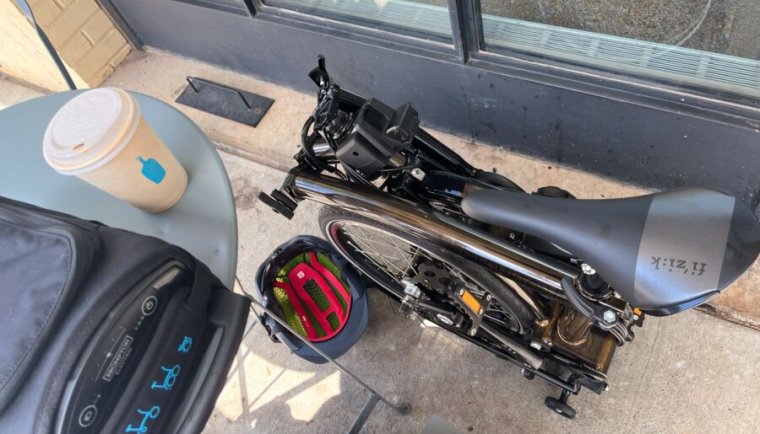
There’s never been a better time to ride a weird bike.
That’s especially true if you live in a city where you can regularly see kids being dropped off at schools from cargo bikes with buckets, child seats, and full rain covers. Further out from the urban core, fat-tire e-bikes share space on trails with three-wheelers, retro-style cruisers, and slick roadies. And folding bikes, once an obscurity, are showing up in more places, especially as they’ve gone electric.
So when I got to try out the Brompton Electric C Line (in a six-speed model), I felt far less intimidated riding, folding, and stashing the little guy wherever I went than I might have been a few years back. A few folks recognized the distinctively small and British bike and offered a thumbs-up or light curiosity. If anyone was concerned about the oddity of this quirky ride, it was me, mostly because I obsessed over whether I could and should lock it up outside or not.
But for the most part, the Brompton fits in, and it works as a bike. It sat next to me at bars and coffee shops and outdoor eateries, it rode the DC Metro, it went on a memorial group ride, and it went to the grocery store. I repeatedly hauled it to a third-floor walkup apartment and brought it on a week’s vacation, fitting it on the floor behind the car driver’s seat. And with an electric battery pack, it was even easier to forget that it was any different from a stereotypical bike—so long as you didn’t look down.
Still, should you pay a good deal more than $3,000 (and probably more like $4,000 after accessories) for a bike with 16-inch tires—especially one you might never want to leave locked up outside?Advertisement
Let’s get into that.
- The Brompton C Line, pre-fold (mid-beer). Kevin Purdy
- Step 1: Release a clasp and pull the bike frame up, allowing the rear wheel to swing forward underneath. Kevin Purdy
- Step 2: Loosen the clamp and fold the front half back to align with the rear wheel, lining up a little hook on the wheel with the frame. Kevin Purdy
- Step 3: Remove the battery (technically unnecessary, but wise), loosen a clamp holding up the handlebar, then fold it down onto the frame, letting a nub tuck into a locking notch. Kevin Purdy
- Step 4: Drop down the seat (which also locks the frame into position), rotate one pedal onto the tire, and flip the other pedal up. Kevin Purdy
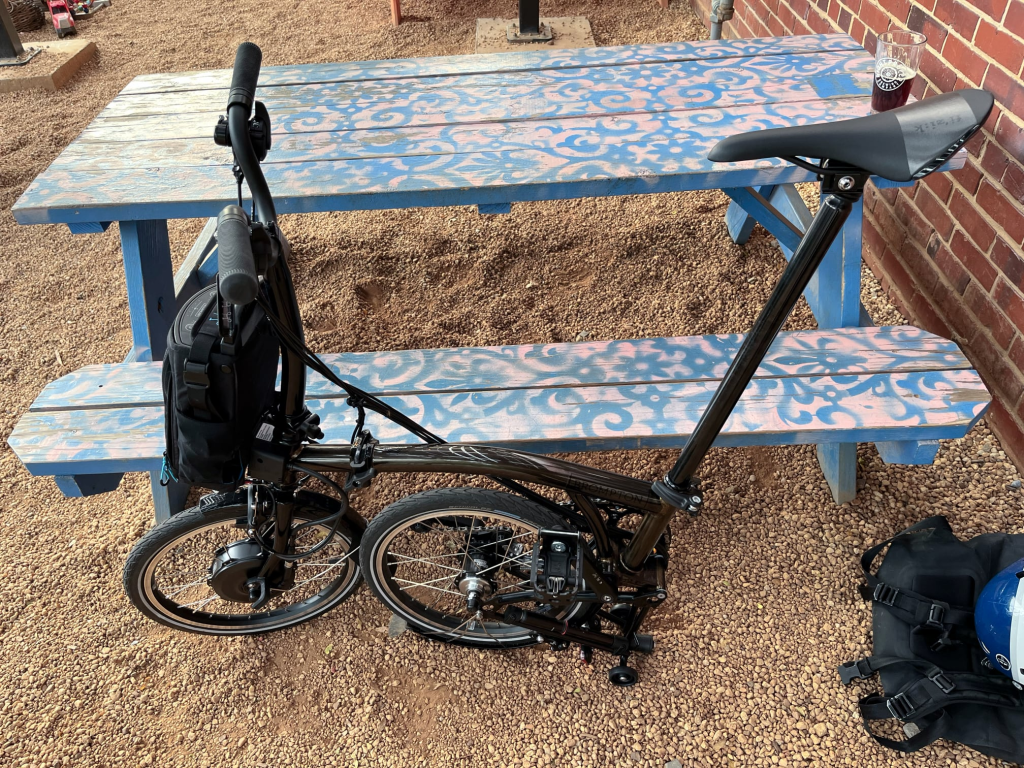
Learning The Fold
Whether you buy it at a store or have it shipped to you, a Brompton C Line is possibly the easiest e-bike to unpack, set up, and get rolling. You take out the folded-up bike, screw in the crucial hinge clamps that hold it together, put on the saddle, and learn how to unfold it for the first time. Throw some air in the tires, and you could be on your way about 20 minutes after getting the bike.
But you shouldn’t head out without getting some reps in on The Fold. The Fold is the reason the Brompton exists. It hasn’t actually changed that much since Andrew Ritchie designed it in 1975. Release a rear frame clip and yank the frame up, and the rear wheel and its frame triangle roll underneath the top tube. Unscrew a hinged clamp, then “stir” the front wheel backward, allowing a subtle hook to catch on the rear frame. Drop the seat and you’ll feel something lock inside the frame. You can then unhinge and fold the handlebar down, or you can keep it up to push the bike around on its tiny frame wheels in “shopping cart mode.”
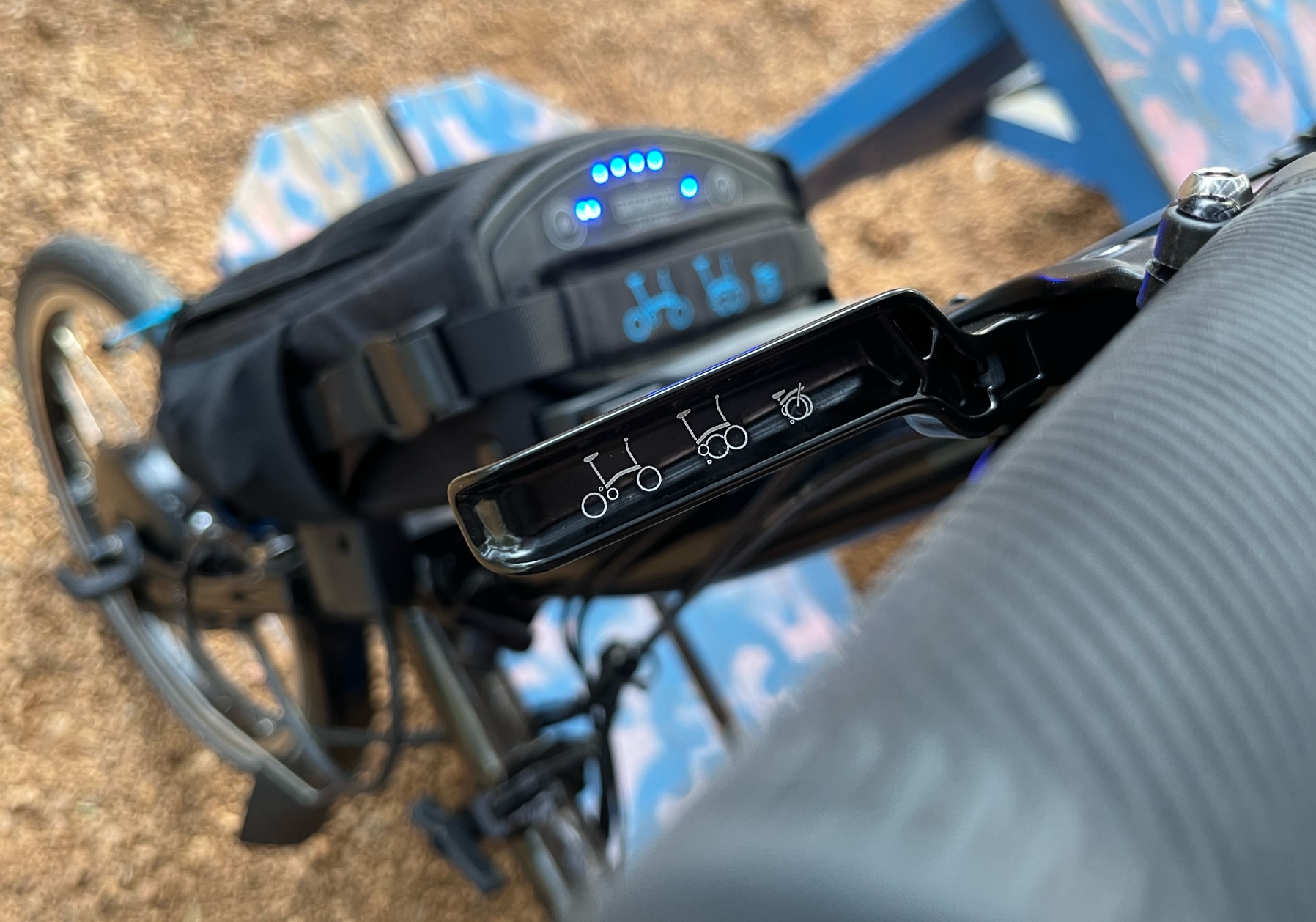
After maybe five attempts, I began to get The Fold done in less than a minute. After around a dozen tries, I started to appreciate its design and motions. The way a Brompton folds up is great for certain applications, like fitting into a car instead of using a rack, bringing on public transit or train rides, tucking underneath a counter or table, or fitting into the corner of the most space-challenged home. It can also be handy if you’re heading somewhere you’re wary of locking it up outside (more on that in a moment).
ARS VIDEO
How The Callisto Protocol’s Team Designed Its Terrifying, Immersive Audio

It’s less wonderful for actively moving around while folded up unless you invest further in a rack, bigger wheels, wheels that spin, or all three. I have tried using the Brompton in “shopping cart mode” as an actual shopping cart, and I had to offer my apologies to a number of neighbors in our cramped local organic food store. Wheeling it onto a DC Metro car was less tricky, though I had to pick it up by the top bar a few times to get through a gate or over a gap.
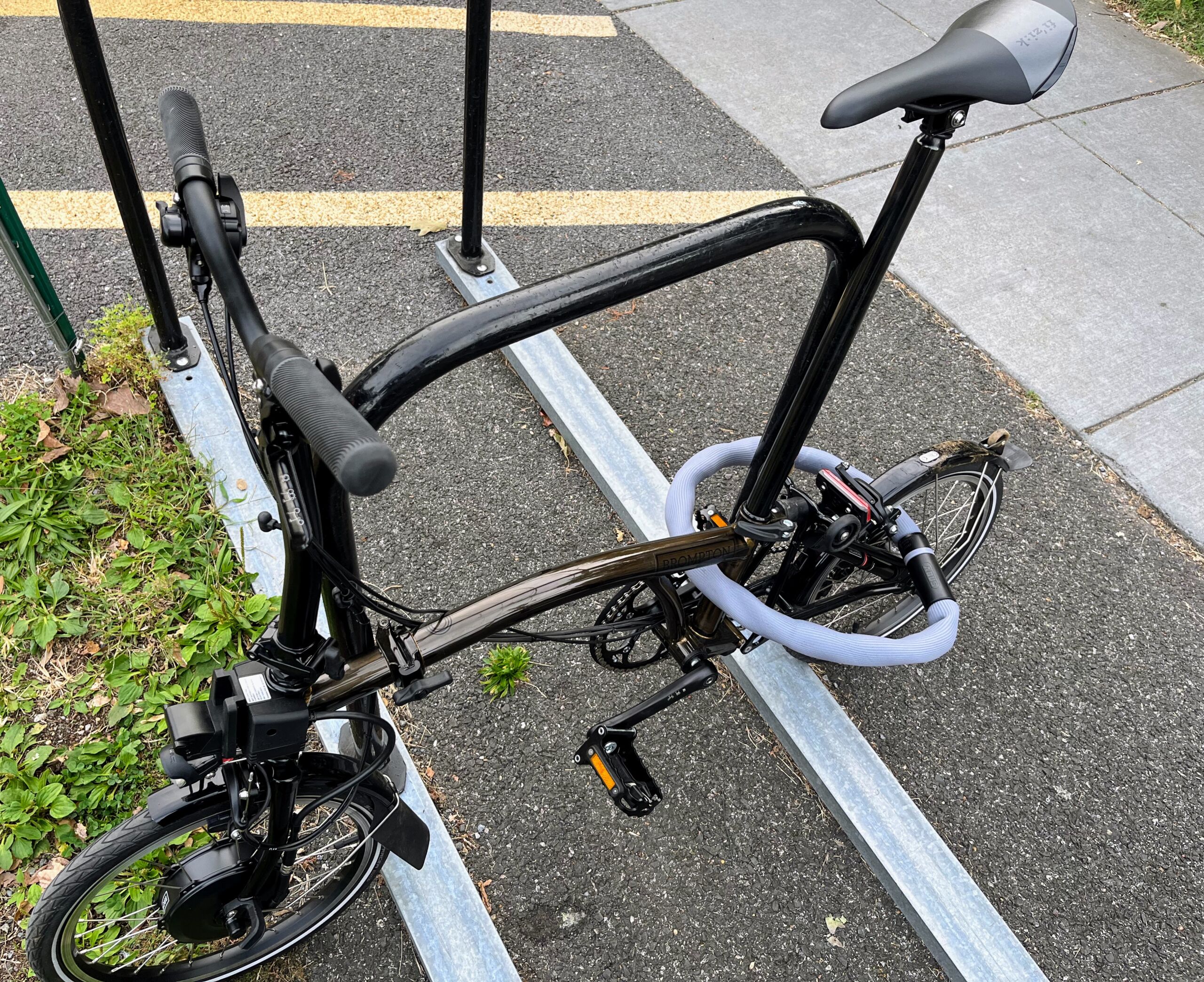
You don’t lock it up
Perhaps the biggest shift in biking mentality the Brompton requires is what you do with it when you arrive at a destination. Thinking through what I would do with my Brompton tripped me up when I was planning a few of my test rides. Lots of Brompton veterans will tell you to never lock the bike up outside, folded or unfolded, because its cost, portability, and easily recognized shape make it a very appealing target for thieves. The Brompton company does not recommend leaving Bromptons outside. “The beauty of the bike is its ability to go anywhere,” a representative wrote in response when I asked their official stance on this.Advertisement
Two friends of mine, veteran Bromptonians who have bike-packed through India with their folding bikes, told me they never lock theirs up outside. If they anticipate resistance to bringing it inside someplace, they’ll occassionally bring along a black fabric sheet or a suitcase of adequate size and simply act like they have arrived from the airport with weird bags. Restaurant hosts and store owners are generally less hostile about luggage than bikes, they told me.
Brompton’s design is intended to get more people on a bike, especially those who think they could not otherwise do so. The company has been perfecting their design for nearly 50 years. Not everyone needs one, and “just bring it inside” won’t work for everyone. If you easily have the room to store a full-size bike at work or home, don’t want to cover the last section of a transit commute with a bike that can fit under your desk, or simply don’t value compactness at such a cost, you should probably buy something else.
But out of all the bikes I’ve ridden in my life, my time with a Brompton stands out. It is a fun, funky bike, and it handles and feels far better than I thought it would. And when it’s convenient to unfold, ride, and then fold up again, it’s quite convenient.
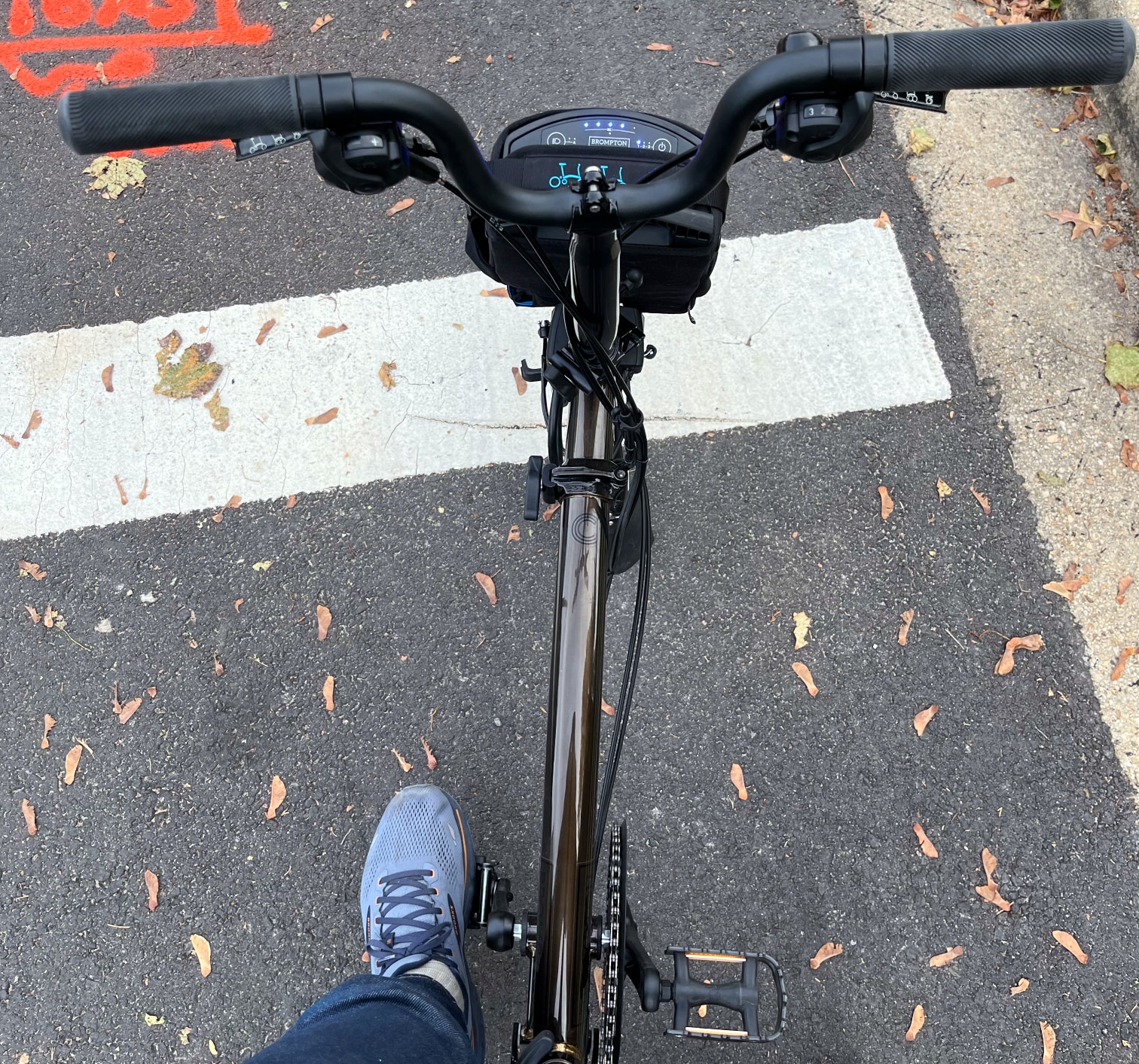
Actually riding this thing
Every time I have ridden an e-bike, I complain about the sizing. The e-bike world typically uses T-shirt-like general sizes like “Medium” and “Large” instead of going by individual frame lengths. As a 6-foot-2-inch guy, that means I’m forever straining my shoulders and feeling the pavement through my wrists, waiting for the day someone makes a pre-built e-bike just for me.
Oddly enough, that personalized e-bike might just have 16-inch wheels. The C Line Electric 6-Speed I received had a medium-height handlebar (there are two sizes), extended seatpost (out of three), and wide saddle, picked out for me by Brompton. I was deeply skeptical that this relatively small bike would feel like anything other than a kid’s bike I grabbed from someone’s yard to use for a joyride.
It did turn out to be a joyride, but not the illicit kind. Riding the Brompton C Line was different—and often fun. You’re closer to the ground, so you have the sense you can hop off the pedals at any time. The turning radius is tighter, so reactions can be quicker. Leaning into a turn involves more leaning. A friend who borrowed my C Line for a lunch excursion said it reminded him of his childhood BMX bike. I felt strangely comfortable, with my hips and shoulders roughly where I wanted them to be and getting full leg extensions without hunching forward.
You can’t pretend there aren’t differences, though, and most of them come down to wheel size and frame geometry. More than with other bikes, you feel and must look out for potholes, road debris, and especially drainage grates that might be about as wide as your tires. Your tires will thank you, but so will your hands and arms, which take up more shocks in a relatively forward-shifted riding position. And if you’re used to leaning heavily into your turns, that’s not the best idea on a Brompton, though your traction will vary.Advertisement
A Brompton’s shifting is also a bit different from what you might be used to. My test model had six gears, divided into two shifting levels, but not by a front chainring. With other internal-geared hub shifters, I find that the bike resists shifting while the bike is moving and has pressure on the pedals. The Brompton essentially refused to shift if I was pedaling. This is by design, and the upside is that you can shift while completely stopped, like at a red light. But if you’re coming from almost any other kind of shifting, it will take some adjustment time.
I have two other quibbles with the (non-electric) Brompton ride, though they’re both easily remedied. The Fizik saddle on my test unit wasn’t my favorite. I would trade it for an original Brompton saddle, which has a lightly padded underside meant for bike carrying. Or, given how reticent I would be to lock the bike up outside, and allowing for a kind of “what’s a few hundred more” fallacy, I might swing for a Brooks saddle. If I had to choose, though, I’d upgrade the grips first, as they were my least favorite thing about this bike.
Both seat and grips were tolerable for short city commutes, but they’d likely wear on you on longer rides. I’m sure folks have proudly done long rides on their Brompton, but it’s not what they’re made for. Different tools for different jobs.
- You can leave the battery on the Brompton if you’re just taking a break. Kevin Purdy
- The top of the Brompton battery bag, with buttons for the headlight mode and assist level. Kevin Purdy
- The Brompton battery from the front. There’s a bit of room in the front pocket for small items. The handlebar has a button that releases the battery from the cargo clip. The shoulder strap is a very nice touch.
- The battery powers the headlamp on the Brompton. Kevin Purdy

What the electric part does
It might seem a little silly, taking a bike meant for portability and mechanical elegance and snapping a battery and motor onto it. But for certain Brompton riders, an electric folding bike might open up new realms of riding.
The electric aspect helps a lot with some of the Brompton’s inherent quirks. With battery boost, hills don’t feel quite so challenging, and speed is easier to maintain (especially alongside full-sized bikes). As with other e-bikes, a battery pack (this one 350 watt-hours) extends your mental range of how far you could or should travel. Brompton rates the battery at 20–45 miles of assisted range, with a full recharge within four hours, and none of my rides made me doubt that.
Brompton’s battery pack is detachable and connects to the front luggage clip. It’s activated by pedal cadence, not pressure, so you’ll still need to shift when you come to a dead stop, and the power isn’t immediate. There are three levels of assist for the 250-watt motor, though I found the first level adequate for all but the most intense climbs. It’s a good thing, too, because given where the battery is mounted, it’s not a great idea to try to adjust it while you’re riding. Both my test-riding friend and I found it a deep reach from the handlebars and not something we felt comfortable doing at any real speed.
The battery also powers the built-in front light, which can automatically turn on in the dark. Its bag gives you a bit of key or wallet storage space. It has Bluetooth built-in, which mostly connects you to the Brompton app for a few neat but unnecessary features (like lifetime mileage tracking).
The Brompton electric kit is otherwise a pretty standard 250-watt, cadence-sensor riding experience. You’ll never feel like you’re flying off the line from a stop, and it takes some pushing to get started. But when you’re pedaling along, you feel like the strongest version of yourself.

Who should actually buy this thing?
Brompton has been making the same basic bicycle design for nearly 50 years in the UK, and you can see and feel that confidence in the fit, finish, and obsessively thought-through details (like the hand pump that tucks into a frame tube). For certain people who love bikes but have spaces or commutes that don’t quite fit them, it’s a highly engineered solution. There are other folding bikes out there, some of them electric and most of them cheaper. But Bromptons have parts, dealerships, and an estimated 8 gazillion videos about fixing every part of your very familiar bike (in addition to Brompton’s own extensive resources).Advertisement
If you’re even a little interested, I think you should give a Brompton a try, either at a dealer or an official Brompton store. If you like everything about the Brompton except the thought of regular hill-climbing or longer distances, the electric models could fit you just fine. The clip-on, easy-to-hold battery is the easiest kind to charge, stash, and transport, and there’s not much of a trade-off from the main bike experience other than front cargo space.
But an electric Brompton is not what you buy for long weekend rides or a new exercise routine. It’s also not what you buy if you don’t have a safe indoor space, at work or at home, to store nearly $4,000 worth of bike. Its shape makes it easier to store, carry, and roll, but it’s still 38 pounds, so it’s not an obvious fix for having lots of stairs.
Still, of all the bikes I’ve tested and either returned or donated, it’s the one I miss the most. There are moments I wish I once again had a quirky little bike to bring along for social meet-ups, for odd errands, or even on road trips. I fondly recall dropping my car off for service, grabbing the Brompton from the trunk, unfolding it, and riding it back home, rather than waiting for a shuttle to never show up or wandering through nearby suburban parking lots.
The Brompton C Line Electric is a weird bike in the best sense of the term. It is both more and less convenient than a standard-sized bike. The ride is quirky, bumpy, and freeing. The bike has small tires and feels nimble. You shouldn’t write it off until you try one.
Listing image by Kevin Purdy




